ST. JOHN'S, N.L. — Newfoundland and Labrador's long-suffering Muskrat Falls hydroelectricity project has encountered new problems ahead of a final round of testing that must take place during the colder months of the year.
The issues have pushed a round of high-power testing — which the company had hoped to have completed by the end of February — to late March or early April, according to Newfoundland and Labrador Hydro's latest report. And if the tests aren't completed by that time, they won't be able to be performed until October or November.
"Testing requires elevated system loads that would be accommodated by typical temperatures expected in March and April. Hydro expects to perform testing in this time frame," said the report dated March 2 to the province's public utilities board.
The report said a new glitch was discovered in the software that runs a subsea cable stretching across the Strait of Belle Isle, between western Newfoundland and eastern Labrador. Frigid February temperatures have also held up other troubleshooting efforts, as the hydro company can't risk outages during extreme cold, the company said.
N.L. Hydro said it expects the issues to be resolved in time to run high-power tests in a few weeks, adding that there are contingency plans in place if the software problem isn't fixed in time.
Rob Collett, the Crown corporation's vice-president of engineering, said in a recent interview that the high-power test is the last test the project has to pass before it will finally be ready to be declared fully operational.
If it fails, the province will wait at least until it gets cold again — likely October or November, Collett said — for another high-power testing opportunity, and ultimately, for final commissioning.
The Muskrat Falls project has long been a financial thorn in Newfoundland and Labrador's side. It was officially green-lit in 2012 by a then-Progressive Conservative government, with a price tag of about $7.4 billion. Years overdue, its costs have ballooned to more than $13 billion, a figure Premier Andrew Furey described in 2021 as "an anchor around the collective souls of Newfoundland and Labrador."
The main source of recent setbacks for Muskrat Falls has been a 1,100-kilometre-long transmission system, called the Labrador-Island Link, which runs from the Muskrat Falls site in Labrador to a converter station just outside St. John's.
So far, the Labrador-Island Link has been cleared to carry up to 450 megawatts of power, but it's rated for up to 900 megawatts, Collett said. High-power testing will determine if it can smoothly deliver higher volumes of power to the province's grid.
An attempted round of high-power tests using 700 megawatts failed last November, leaving about 58,000 people in the dark for up to 25 minutes. The software problem behind that failure has since been fixed, he said.
Seven hundred megawatts is a "significant amount of power," Collett said, and high-power testing can only be done in winter, when people crank up their thermostats and put enough demand on the grid.
If the next test fails, N.L. Hydro will need time to figure out why and fix the problem, he said. After that, it likely wouldn't be cold enough to run new tests until the late fall.
When asked how much another delay will add to Muskrat Falls's price tag, N.L. Hydro spokesperson Jill Pitcher said in an email that the company will reassess costs after the testing.
"If there are additional costs beyond the contingency in place, this will be captured in the final rate mitigation plan," she said.
This report by The Canadian Press was first published March 3, 2023.
Sarah Smellie, The Canadian Press




